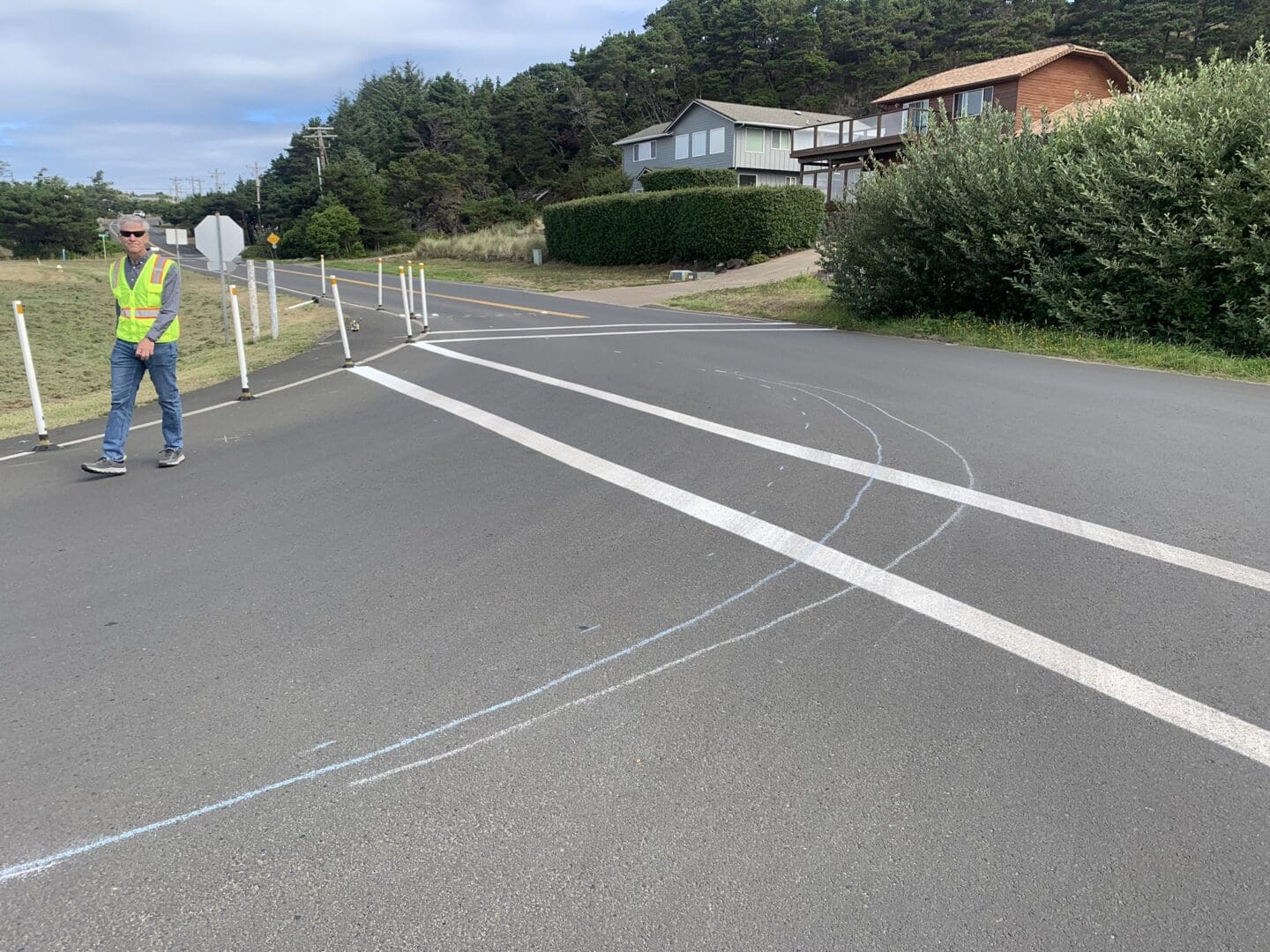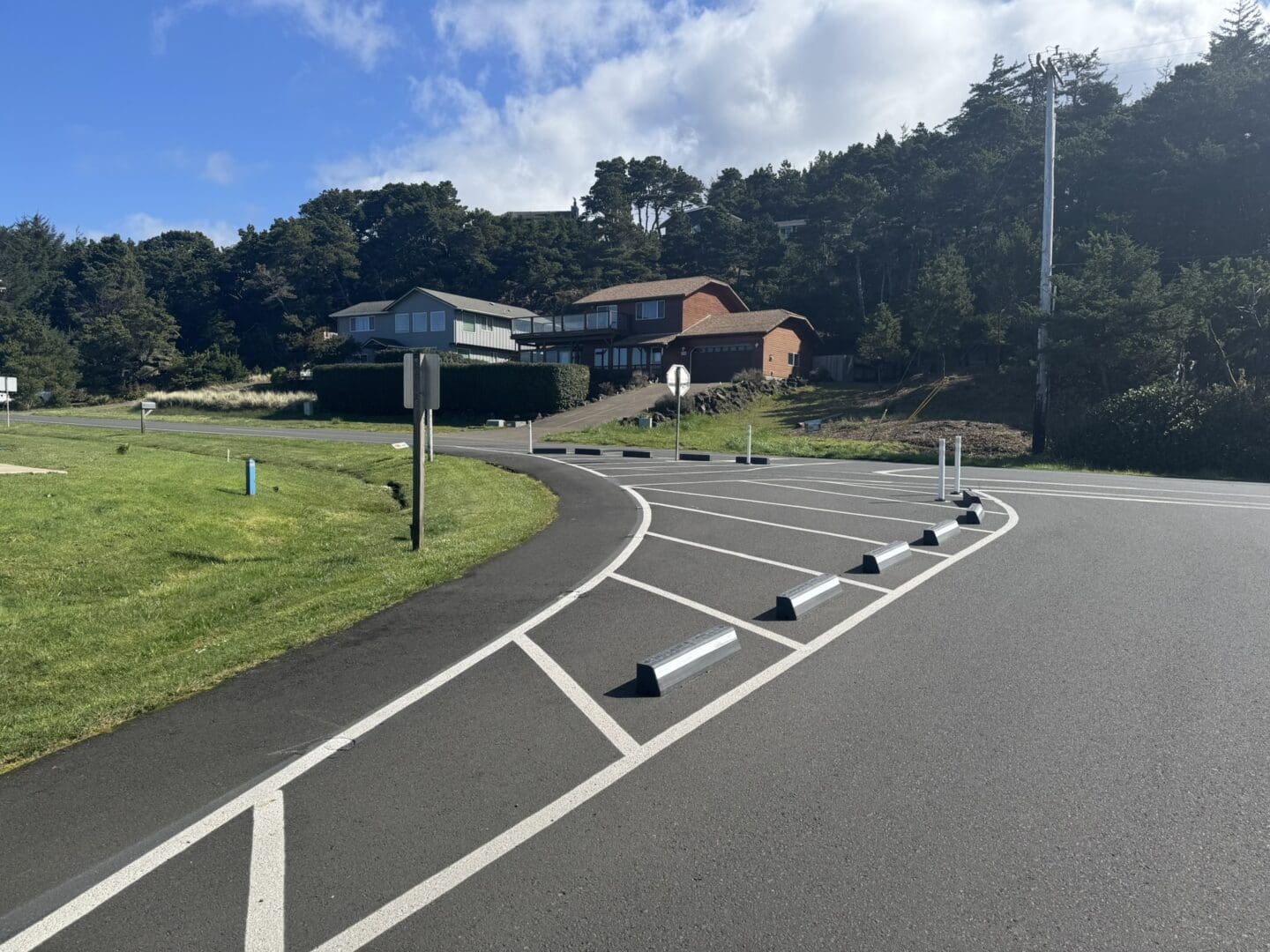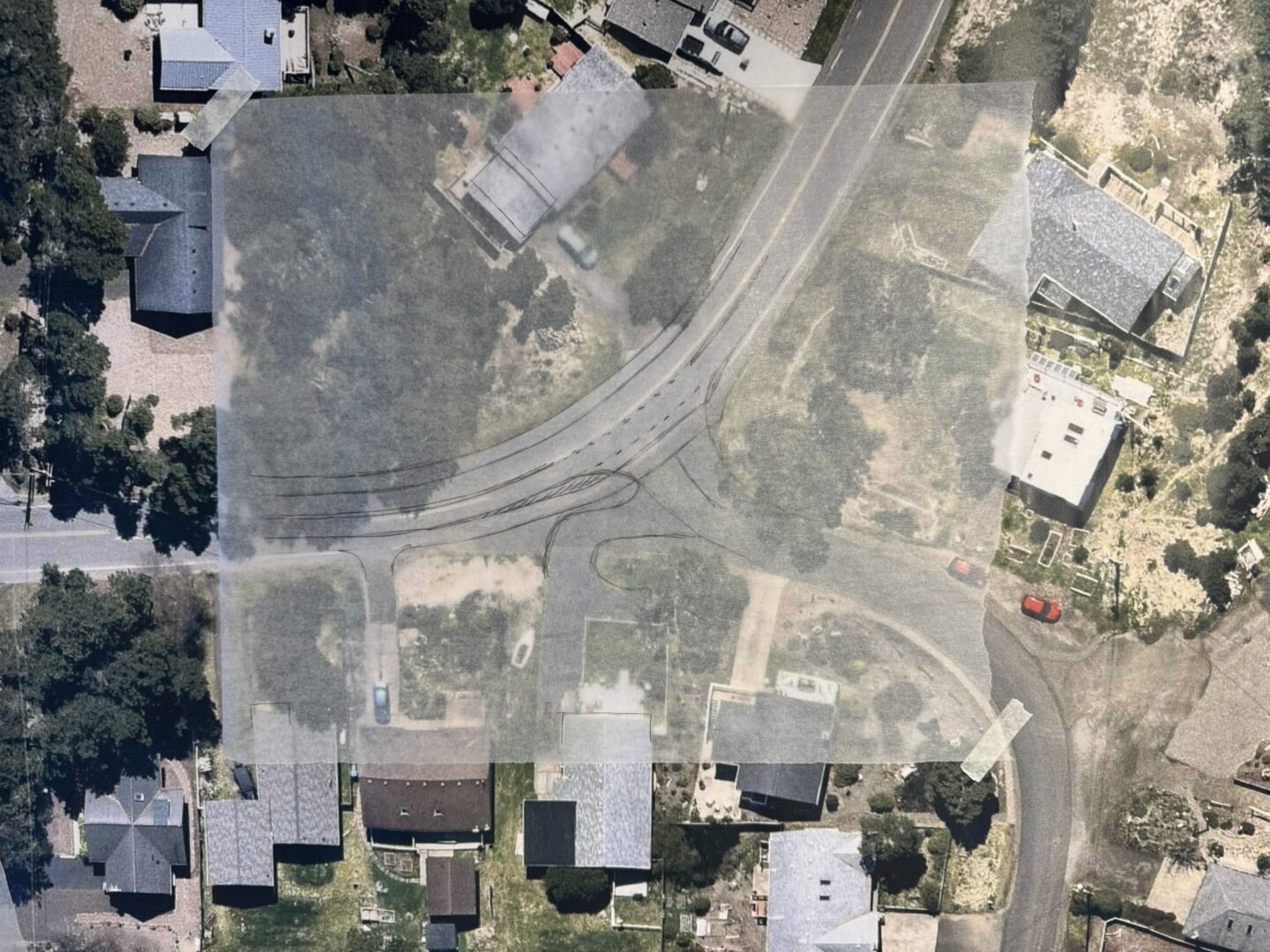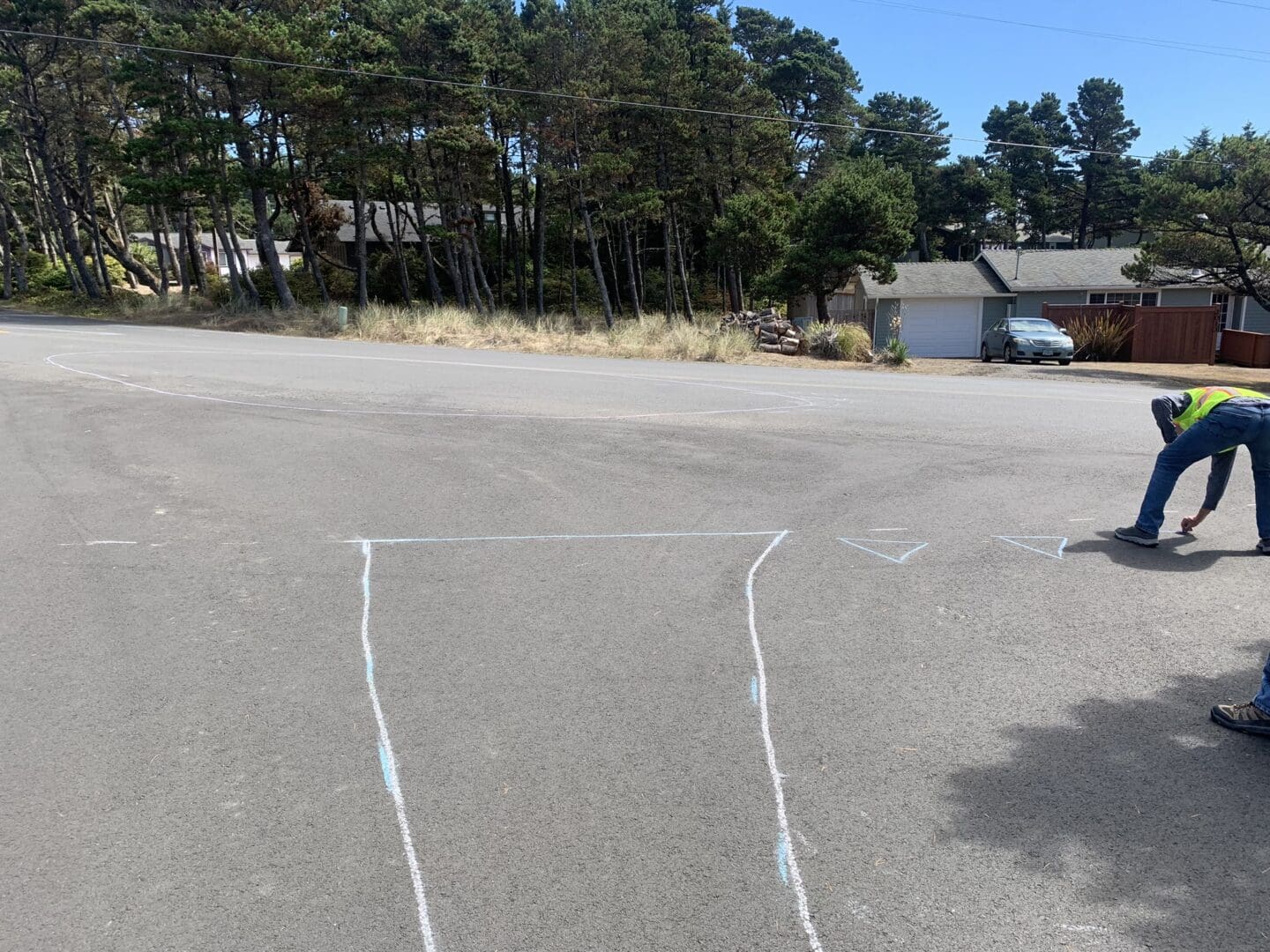October 31, 2025
When thinking about improving your community’s transportation systems, it’s natural to assume that meaningful change requires major investments and years of planning. But that’s not always the case. In fact, some of the most effective improvements are also the simplest. It’s amazing what you can do with paint, signage, and a few rubber curbs!
The community of Bayshore, an unincorporated census area on the coast of Oregon, is a place where small changes have made a big impact. As we’ve worked with the subdivision’s road district to understand community needs and with Lincoln County to design and implement improvements, the Bayshore Road District board says they’ve developed “a whole new way of working with the community and County partners to bring about transformation.” From our perspective, Bayshore has become a compelling example to other small communities and a reminder that low-cost, quick-build treatments can go a long way in creating safer and more livable streets.

“Alsea Bay, Bayshore” by McKenzie Reeves, CC BY-SA 2.0.
Small Changes, Big Wins
Fifteen miles south of Newport, nestled between the Pacific Ocean and the Alsea River, Bayshore is a subdivision on the picturesque Oregon coastline, where thick forests meet sandy beaches and residents and vacationers enjoy scenic views, a cool climate, and a slower pace of life. The roadways that serve the community’s approximately 750 homes are managed by the Bayshore Road District, which formed in the 1970s.
Special districts like the Bayshore Road District are forms of local government established to meet specific community needs, whether by providing specialized services or enhancing existing ones, that fill in gaps or complement broader city or county efforts. The Bayshore Road District works to improve the subdivision’s roads through coordinating maintenance projects and investigating road safety issues. It’s funded through property taxes and presently run by three board members who are also residents of the subdivision: Paul Wellington, Dennis Engeldorf, and Kathi O’Leary.
How did a community that couldn’t feel further from the “big city” get connected with our team in Portland? None other than a Google search! Their quest for a transportation engineer to help them address some roadway safety issues led them to Senior Principal Engineer Hermanus Steyn and Senior Planner Nick Gross via the Kittelson website. The board had never worked with a transportation consulting firm, but Paul, Dennis, and Kathi were open to trying something new.
Hermanus and Nick kicked off our engagement with Bayshore by conducting a road safety audit (RSA), which generated a list of recommended transportation improvements for safety and community wellness. Since then, they’ve been working with the community and Lincoln County to implement the recommendations, prioritizing low-cost and often simple changes that have led to immediate impact.
One of the primary concerns on the board’s radar was speeding on NW Bayshore Drive, the main road into the subdivision. After receiving community complaints that were reinforced by their own observations and experiences, board members talked to the sheriff’s department and learned that about 20% of the approximately 800 cars that use the road every day were driving at ticketable speeds, creating unsafe conditions for all road users. Thus, one of the first action items that came out of the RSA was designing and implementing speed humps, which have noticeably reduced speeds.
Other changes along NW Bayshore Drive included tightening the radius of a turn that drivers were taking at high speeds and restriping the road to create wider shoulders—both low-cost improvements using just paint and rubber curbs. Previously, pedestrians had to travel uncomfortably close to cars or in ditches on the sides of the road. The combination of speed management techniques and a wider shoulder has increased the number of people who feel comfortable going on foot.
“On our first visit to Bayshore, we rarely saw anyone walking. Now when we visit we see people walking all over the place,” said Hermanus.

The “before” shot of the intersection of NW Bayshore Drive and NW Westward Ho Drive, which many drivers took at high speeds without stopping.

A tighter curb radius, created with paint and rubber curbs, has reduced speeds and created more separation between drivers and pedestrians on the turn.
“How Are We Supposed to Know?”
For years, the Bayshore Road District operated like many small agencies—focused on finding the most straightforward path forward, seeing coordination with other entities as more of a hassle than a help. They managed maintenance projects like annual street paving and coordinated responses to safety concerns brought to their attention from resident complaints. However, in a community as engaged as Bayshore, they felt challenged by navigating competing opinions and prioritizing projects.
“One of the first discussions we had with the board was when and how to get input,” said Hermanus. “Once we had a list of intended improvements from the RSA, we met with Lincoln County to share the ideas and get their support. We also worked on proactive ways of connecting with residents to hear what’s important to them.”
In their engagements with residents, the board worked with Hermanus and Nick to communicate the why behind the what—how reducing driving speeds and creating more walkable spaces contributes to keeping Bayshore the idyllic coastal neighborhood it’s known as. As some of the changes have become constructed, the board says they’ve noticed more residents engage in discussions about future roadway projects.
“We’ve learned how to work with everyone,” says Paul, who serves as chairman of the board. “Hermanus and Nick took the time to understand how we operate and help us coordinate with HOAs, emergency services, the sheriff’s department, and the community. And it’s changing the whole outlook of the place.”
Through this process, Paul, Kathi, and Dennis have built strong relationships with Lincoln County, which serves as the authority on road design in Bayshore. Impressed by the care the board has taken to hear from residents and work with local partners, the County now points to Bayshore as an example for other small communities. The board credits this collaborative approach, combined with leaning on Hermanus and Nick’s expertise, with allowing them to more confidently fill the special district’s purpose: providing services that improve the safety of Bayshore’s roads.
“It is our primary objective to keep everyone safe,” says Dennis, who serves as the board’s secretary. “Working with an engineering firm gives us a path forward. We listen to what the community is saying, collect information and data, present the issues to Hermanus and Nick, and then they give us their professional recommendation for the best course of action.”

NW Bayshore Drive after it was restriped to create narrower travel lanes and wider shoulders for pedestrians.
Lessons from Bayshore’s Evolving Approach to Transportation
For communities of all sizes, Bayshore sets the example of starting where you are and with that you have. You don’t need to hold out for a big budget or large team to start creating change. We’d summarize our takeaways from working with this special subdivision in a few points:
- Creative doesn’t have to be complicated. Hermanus and Nick could have added more people, tools, and processes to the tasks of restriping the road, redesigning the curb radius, and implementing speed humps, but in this case, simple was sufficient and allowed Bayshore to get the improvements on the ground for a fraction of the cost that these types of projects can often take. As more communities are open to creative, quick-build solutions, more transportation improvements will transform our streets.
- With every community we work with, we should ask what we can do with what they have. Some communities need complex sidewalk designs with stormwater drainage. But many don’t have the resources for that. If low-cost materials can help us get something on the ground that’s safer, practical, and legally compliant, we should prioritize the simple but immediate improvement over waiting for the elaborate solution that may take years or never come to fruition.
- Presenting proposed improvements doesn’t have to be elaborate, either. To illustrate what some of Bayshore’s roadway changes could look like, Hermanus and Nick sketched on aerial images and marked the road with chalk. There’s a time and place for advanced visualization technology (we’re all about it!), but a detailed 3D visualization would be a mismatch with a low-cost, quick-build improvement. In the case of Bayshore, a bucket of chalk helped the community visualize what we were talking about, and their feedback advanced some projects and tabled others.

Hermanus and Nick used sketches on aerial images, like this one, to talk through proposed improvements with board and community members.

Chalk on the road helped residents visualize some of the changes, like this roundabout, which they ultimately decided not to move forward.
You Don’t Have to Have All the Answers
For small agencies with limited resources or volunteer-run road districts like Bayshore’s, the idea of improving transportation infrastructure can feel overwhelming. How should you spend your time and resources to address the most important issues (and how are you supposed to know what those issues are?).
For other volunteer-run special districts, the Bayshore Road District board advises defining a collaborative process and surrounding yourself with a team that takes away the pressure to have all the answers, especially when it comes to road design decisions.
“Make it your job to handle the maintenance of your existing roads and not the design of your roads,” says the board. “When a resident voices a complaint that involves the design of a road, such as speed humps, intersection changes, or new curbs, consult with a trusted engineering partner who can evaluate whether a concern warrants a design change.”
Bayshore’s process involves having engineers develop MUTCD-compliant designs, which are then submitted to the appropriate regulatory agency for approval. Not only does this make for safer streets, but when changes come from a neutral, qualified source, residents are less likely to direct frustration at volunteer board members.
The board also emphasizes that collaborating with other agencies takes up-front effort but pays dividends in the long run. “Work with the governmental agency that enforces those laws and don’t try to operate independently,” they encourage. Since the Bayshore Road District is not the final decision-making entity when it comes to road design, aligning proactively on shared goals and vision with Lincoln County (the agency overseeing the district’s roads), as well as getting feedback from other local partners (like the HOA, emergency services, the sheriff’s department, and residents directly) when the Kittelson team provides more than one viable option for a road design change, helps ensure that community priorities are heard and acted on. Coordination isn’t just helpful—it’s essential to getting things done.
All in all, Bayshore reminds us that you don’t need a big budget or team to make meaningful improvements, and you also don’t have to go it alone. Sometimes, all it takes is a willingness to engage, a few trusted partners, and the confidence to take that first step.
If you’d like to learn more about our work in Bayshore, contact Hermanus and Nick here.
